
Concept explainers
(a)
Interpretation: The structure that corresponds to the given name is to be drawn.
Concept introduction: One should follow the given three steps to derive the structure of the compound from its IUPAC name. The first step involves the identification of parent name and
Answer to Problem 25.39P
The structure that corresponds to the given name is,
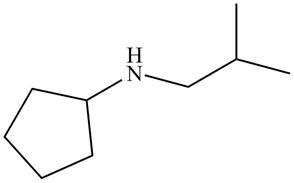
Figure 1
Explanation of Solution
The name of the given molecule suggests that a nitrogen atom is bonded to cyclopentane and isobutyl group. Cyclopentane consists of five carbon atoms. Therefore, the structure of the given compound is,
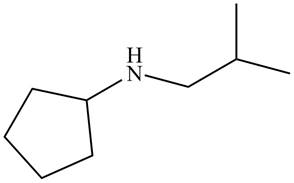
Figure 1
The structure that corresponds to the given name is shown in Figure 1.
(b)
Interpretation: The structure that corresponds to the given name is to be drawn.
Concept introduction: One should follow the given three steps to derive the structure of the compound from its IUPAC name. The first step involves the identification of parent name and functional group found at the end of the name. The second step is numbering of carbon skeleton in either direction. The third step is addition of substituents at appropriate carbon atoms.
Answer to Problem 25.39P
The structure that corresponds to the given name is,
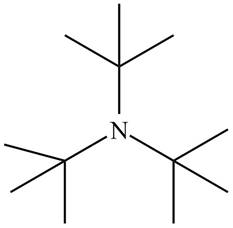
Figure 2
Explanation of Solution
The name of the given compound is tri-tert-butylamine. Prefix ‘tri’ shows that a nitrogen atom is bonded to three tert-butyl groups. Therefore, the structure of the given compound is,
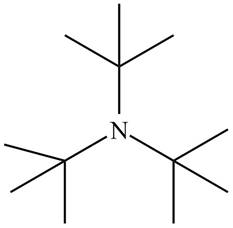
Figure 2
The structure that corresponds to the given name is shown in Figure 2.
(c)
Interpretation: The structure that corresponds to the given name is to be drawn.
Concept introduction: One should follow the given three steps to derive the structure of the compound from its IUPAC name. The first step involves the identification of parent name and functional group found at the end of the name. The second step is numbering of carbon skeleton in either direction. The third step is addition of substituents at appropriate carbon atoms.
Answer to Problem 25.39P
The structure that corresponds to the given name is,
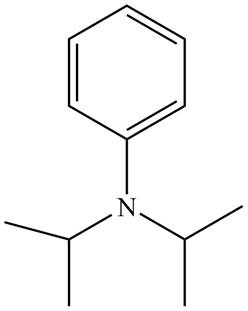
Figure 3
Explanation of Solution
The name of the given compound is N, N-diisopropylaniline. Prefix ‘di’ shows that a nitrogen atom is bonded to two isopropyl groups and it is bonded to six membered
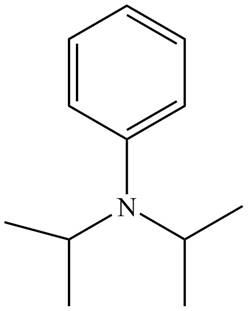
Figure 3
The structure that corresponds to the given name is shown in Figure 3.
(d)
Interpretation: The structure that corresponds to the given name is to be drawn.
Concept introduction: One should follow the given three steps to derive the structure of the compound from its IUPAC name. The first step involves the identification of parent name and functional group found at the end of the name. The second step is numbering of carbon skeleton in either direction. The third step is addition of substituents at appropriate carbon atoms.
Answer to Problem 25.39P
The structure that corresponds to the given name is,
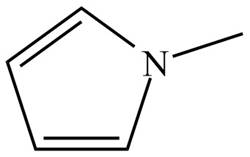
Figure 4
Explanation of Solution
The name of the given compound is N-methylpyrrole. Pyrrole is the parent chain of the given compound. It is an aromatic five membered ring which contains nitrogen atom and two double bonds. The nitrogen atom is bonded to methyl group. Therefore, the structure of the given compound is,

Figure 4
The structure that corresponds to the given name is shown in Figure 4.
(e)
Interpretation: The structure that corresponds to the given name is to be drawn.
Concept introduction: One should follow the given three steps to derive the structure of the compound from its IUPAC name. The first step involves the identification of parent name and functional group found at the end of the name. The second step is numbering of carbon skeleton in either direction. The third step is addition of substituents at appropriate carbon atoms.
Answer to Problem 25.39P
The structure that corresponds to the given name is,
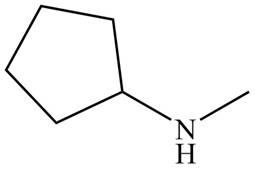
Figure 5
Explanation of Solution
The name of the given compound is N-methylcyclopentanamine. The name suggests that nitrogen atom is bonded to cyclopentane and methyl group. Therefore, the structure of the given compound is,

Figure 5
The structure that corresponds to the given name is shown in Figure 5.
(f)
Interpretation: The structure that corresponds to the given name is to be drawn.
Concept introduction: One should follow the given three steps to derive the structure of the compound from its IUPAC name. The first step involves the identification of parent name and functional group found at the end of the name. The second step is numbering of carbon skeleton in either direction. The third step is addition of substituents at appropriate carbon atoms.
Answer to Problem 25.39P
The structure that corresponds to the given name is,
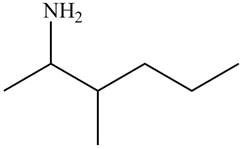
Figure 6
Explanation of Solution
The name of the given compound is

Figure 6
The structure that corresponds to the given name is shown in Figure 6.
(g)
Interpretation: The structure that corresponds to the given name is to be drawn.
Concept introduction: One should follow the given three steps to derive the structure of the compound from its IUPAC name. The first step involves the identification of parent name and functional group found at the end of the name. The second step is numbering of carbon skeleton in either direction. The third step is addition of substituents at appropriate carbon atoms.
Answer to Problem 25.39P
The structure that corresponds to the given name is,

Figure 7
Explanation of Solution
The name of the given compound is

Figure 7
The structure that corresponds to the given name is shown in Figure 7.
(h)
Interpretation: The structure that corresponds to the given name is to be drawn.
Concept introduction: One should follow the given three steps to derive the structure of the compound from its IUPAC name. The first step involves the identification of parent name and functional group found at the end of the name. The second step is numbering of carbon skeleton in either direction. The third step is addition of substituents at appropriate carbon atoms.
Answer to Problem 25.39P
The structure that corresponds to the given name is,
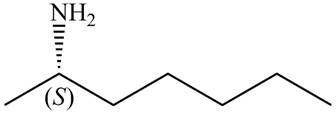
Figure 8
Explanation of Solution
The name of the given compound is (S)-heptan-

Figure 8
The structure that corresponds to the given name is shown in Figure 8.
Want to see more full solutions like this?
Chapter 25 Solutions
Organic Chemistry
- Order the following series of compounds from highest to lowest reactivity to electrophilic aromatic substitution, explaining your answer: 2-nitrophenol, p-Toluidine, N-(4-methylphenyl)acetamide, 4-methylbenzonitrile, 4-(trifluoromethyl)benzonitrile.arrow_forwardOrdene la siguiente serie de compuestos de mayor a menor reactividad a la sustitución aromática electrofílica, explicando su respuesta: ácido bencenosulfónico, fluorobenceno, etilbenceno, clorobenceno, terc-butilbenceno, acetofenona.arrow_forwardCan I please get all final concentrations please!arrow_forward
- State the detailed mechanism of the reaction of benzene with isopropanol in sulfuric acid.arrow_forwardDo not apply the calculations, based on the approximation of the stationary state, to make them perform correctly. Basta discard the 3 responses that you encounter that are obviously erroneous if you apply the formula to determine the speed of a reaction. For the decomposition reaction of N2O5(g): 2 N2O5(g) · 4 NO2(g) + O2(g), the following mechanism has been proposed: N2O5 -> NO2 + NO3_(K1) NO2 + NO3 →> N2O5 (k-1) → NO2 + NO3 → NO2 + O2 + NO (K2) NO + N2O5 → NO2 + NO2 + NO2 (K3) Give the expression for the acceptable rate. (A). d[N₂O] dt = -1 2k,k₂[N205] k₁+k₂ d[N₂O5] (B). dt =-k₁[N₂O₂] + k₁[NO2][NO3] - k₂[NO2]³ (C). d[N₂O] dt =-k₁[N₂O] + k₁[N205] - K3 [NO] [N205] (D). d[N2O5] =-k₁[NO] - K3[NO] [N₂05] dtarrow_forwardA 0.10 M solution of acetic acid (CH3COOH, Ka = 1.8 x 10^-5) is titrated with a 0.0250 M solution of magnesium hydroxide (Mg(OH)2). If 10.0 mL of the acid solution is titrated with 20.0 mL of the base solution, what is the pH of the resulting solution?arrow_forward
- For the decomposition reaction of N2O5(g): 2 N2O5(g) → 4 NO2(g) + O2(g), the following mechanism has been proposed: N2O5 NO2 + NO3 (K1) | NO2 + NO3 → N2O5 (k-1) | NO2 + NO3 NO2 + O2 + NO (k2) | NO + N2O51 NO2 + NO2 + NO2 (K3) → Give the expression for the acceptable rate. → → (A). d[N205] dt == 2k,k₂[N₂O₂] k₁+k₁₂ (B). d[N2O5] =-k₁[N₂O] + k₁[NO₂] [NO3] - k₂[NO₂]³ dt (C). d[N2O5] =-k₁[N₂O] + k [NO] - k₂[NO] [NO] d[N2O5] (D). = dt = -k₁[N2O5] - k¸[NO][N₂05] dt Do not apply the calculations, based on the approximation of the stationary state, to make them perform correctly. Basta discard the 3 responses that you encounter that are obviously erroneous if you apply the formula to determine the speed of a reaction.arrow_forwardFor the decomposition reaction of N2O5(g): 2 N2O5(g) → 4 NO2(g) + O2(g), the following mechanism has been proposed: N2O5 NO2 + NO3 (K1) | NO2 + NO3 → N2O5 (k-1) | NO2 + NO3 NO2 + O2 + NO (k2) | NO + N2O51 NO2 + NO2 + NO2 (K3) → Give the expression for the acceptable rate. → → (A). d[N205] dt == 2k,k₂[N₂O₂] k₁+k₁₂ (B). d[N2O5] =-k₁[N₂O] + k₁[NO₂] [NO3] - k₂[NO₂]³ dt (C). d[N2O5] =-k₁[N₂O] + k [NO] - k₂[NO] [NO] d[N2O5] (D). = dt = -k₁[N2O5] - k¸[NO][N₂05] dt Do not apply the calculations, based on the approximation of the stationary state, to make them perform correctly. Basta discard the 3 responses that you encounter that are obviously erroneous if you apply the formula to determine the speed of a reaction.arrow_forwardR lactam or lactone considering as weak acid or weak base and whyarrow_forward
- 81. a. Propose a mechanism for the following reaction: OH CH2=CHCHC=N b. What is the product of the following reaction? HO H₂O N=CCH2CH2CH OH HO CH3CCH=CH2 H₂O C=N 82. Unlike a phosphonium ylide that reacts with an aldehyde or a ketone to form an alkene a sulfonium uliaarrow_forwardFor each reaction below, decide if the first stable organic product that forms in solution will create a new CC bond, and check the appropriate box. Next, for each reaction to which you answered "Yes" to in the table, draw this product in the drawing area below. Note for advanced students: for this problem, don't worry if you think this product will continue to react under the current conditions - just focus on the first stable product you expect to form in solution. ? NH2 MgBr Will the first product that forms in this reaction create a new CC bond? ○ Yes ○ No MgBr ? Will the first product that forms in this reaction create a new CC bond? O Yes O No Click and drag to start drawing a structure. :☐ G x c olo Ar HEarrow_forwardPredicting As the lead product manager at OrganometALEKS Industries, you are trying to decide if the following reaction will make a molecule with a new C - C bond as its major product: H₂N O H 1. ? 2. H3O+ If this reaction will work, draw the major organic product or products you would expect in the drawing area below. If there's more than one major product, you can draw them in any arrangement you like. Be sure you use wedge and dash bonds if necessary, for example to distinguish between major products with different stereochemistry. 0 If the major products of this reaction won't have a new CC bond, just check the box under the drawing area and leave it blank. فا Explanation Check Click and drag to start drawing a structure.arrow_forward
 Organic Chemistry: A Guided InquiryChemistryISBN:9780618974122Author:Andrei StraumanisPublisher:Cengage Learning
Organic Chemistry: A Guided InquiryChemistryISBN:9780618974122Author:Andrei StraumanisPublisher:Cengage Learning
